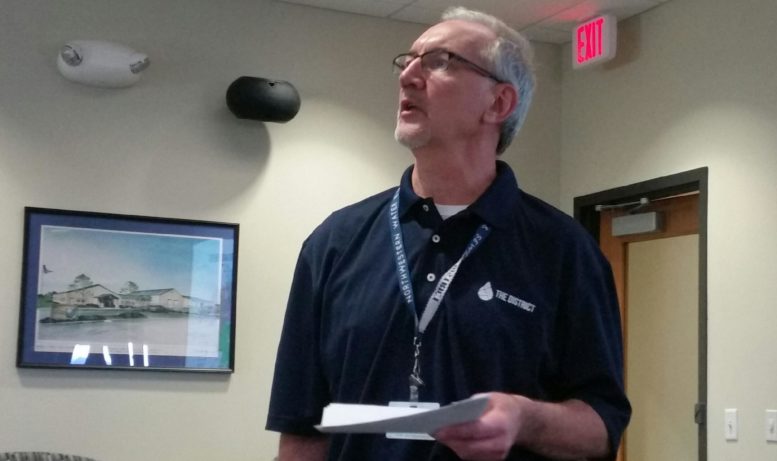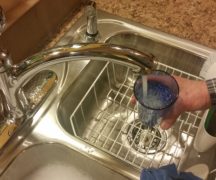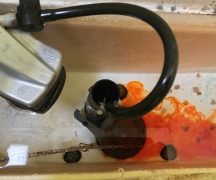By JAN LARSON McLAUGHLIN
BG Independent News
As the water wars continue in Toledo, the Northwestern Water and Sewer District is looking for the best partner to do business with in the region. The more officials study the issue, the better Bowling Green water looks.
“What we’re seriously looking at now is Bowling Green,” NWSD Executive Director Jerry Greiner said Sunday during an open house at the district headquarters located on Ohio 582 between Bowling Green and Perrysburg.
Bowling Green’s value in water services rose to the surface nearly three years ago when the algal bloom crisis prevented Toledo water users from consuming their water. Bowling Green’s water had no problems.
Since then, concerns about Toledo’s water quality and expense has led many areas of the region to reconsider their contracts with Toledo. In addition to large surcharges, surrounding communities are also being forced into tax sharing agreements if Toledo water leads to economic development. “That’s sometimes difficult to swallow,” Greiner said.
The dissatisfaction has led to a great deal of study on alternative water sources – with Bowling Green being one of the options.
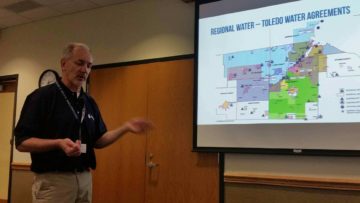
Jerry Greiner talks about water sources in region.
Earlier this year, Waterville switched over to Bowling Green water.
Now the water source is being eyed by three other regions – the Northwestern Water and Sewer District, Perrysburg and Maumee. According to Greiner, Bowling Green currently has enough water capacity at its existing plant to supply one of the three entities. To supply more, the city would need to expand its plant, Greiner said. And the Bowling Green reservoir space has to expand regardless of whether or not more customers are added, he said.
In addition to Bowling Green having quality water to supply, it also may have more reasonable leadership to contract with, Greiner said.
“I have a long-term relationship with Bowling Green,” and the Board of Public Utilities is well established, he added.
“Toledo was easier to deal with years ago,” but that is no longer the case, Greiner said.
The Northwestern Water and Sewer District is already the largest water customer outside the city for Bowling Green water – using more than 1 million gallons a day. Bowling Green water is already sold to many communities outside the city, some supplied through city lines and others through district lines. Those towns getting BG water include Tontogany, Haskins, Grand Rapids, Portage, Rudolph, Weston, Milton Center, Custar, Jerry City, Cygnet, Hoytville, Bloomdale and Bairdstown.
“We truly are regional,” Greiner said.
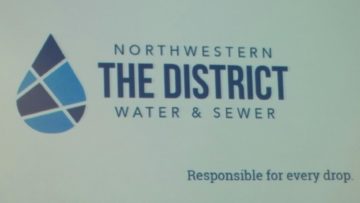
New district logo unveiled at open house
Greiner predicted the most recent study of the water services in the region will be completed in June. “Then we’ll have an idea how to compare Toledo and Bowling Green,” he said.
Earlier this year, Bowling Green officials said they had not yet been approached by other communities beyond Waterville for water services.
“Waterville was looking for different options, to explore what the possibilities were,” Bowling Green Utilities Director Brian O’Connell said in March. “One of those options was to put a pipe under the river to the Bowling Green Water Treatment Plant.”
Bowling Green had the extra water capacity, more reasonable rates, and was willing to give Waterville a 25-year contract compared to Toledo’s offer of a nine-year deal.
“We had additional capacity that could meet their need,” O’Connell said. There were no capital costs for Bowling Green since Waterville put the pipeline under the river to link up along Forst Road to a main from Bowling Green’s water treatment plant.
“Waterville assumed all the capital costs and the debt,” and Bowling Green just has to treat more water, O’Connell said. “It made sense for both communities to do the project. It’s good for our revenue stream.”
The city has a “wholesale contract” to sell the village about 500,000 gallons a day. Bowling Green already treats 4 to 5 million gallons of water a day, with that peaking to 6 to 8 million gallons in the summer.
According to O’Connell, the plant which sits on Ohio 65 along its water source, the Maumee River, could supply roughly 3 million more gallons a day using the plant’s current footprint.
During Sunday’s open house at the Northwestern Water and Sewer District, spokesperson Theresa Pollick said the district was created in 1994, with 23 employees and 6,000 customers. The district now has 70 employees and more than 19,000 customers.

District equipment was put on display for open house.
In the water portion of the district, there are 440 miles of water distribution lines, eight water towers, six master metered water areas, seven pumping station, two ground water tanks, and 3,800 fire hydrants.
In the sewer end of the business, there are 355 miles of collection network, 12 wastewater treatment facilities, 85 pumping stations, 71 submersible stations, 14 wet/dry well configurations, and 5,500 manholes.
The district reached some milestone this year, according to board member Mark Sheffer, including reaching $200 million in assets value taking into account sewer pipes, water towers, trucks, waterlines and other equipment.
The district, which already serves a portion of Sandusky County, also expanded services into Hancock County to serve McComb.
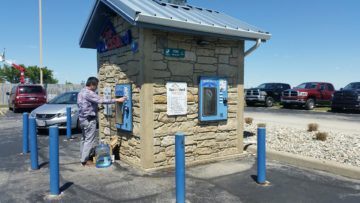
Northwestern Water and Sewer District hit $1 million milestone at its water sheds.
And the eight watershed locations throughout the county reached the $1 million sale mark. “That’s a lot, a lot of water,” Pollick said.
The district’s board of trustees includes Rob Armstrong of Perrysburg Township, Steve Arnold of Bloom Township, John A. Cheney of Henry Township, Bill Hirzel of Lake Township, Melinda Kale of Liberty Township, Leonard Michaels of Rossford, Doug Miller of Perrysburg Township, Mark Sheffer of Weston, and Bill Verbosky of Rossford.
Three board members are appointed by the Wood County Commissioners, three by the township members of the district and three by the municipal members of the district.

